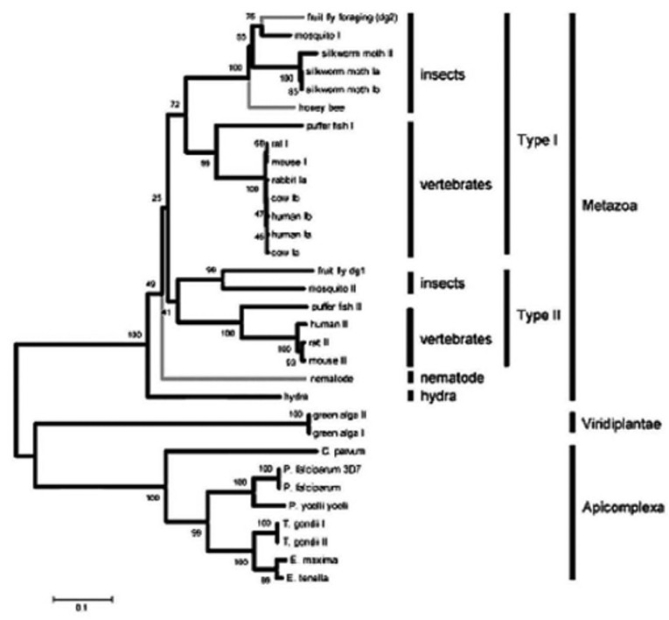Use the following information to answer the following question(s) .
The following are an abstract and figure from a paper that explores the evolutionary relationship between a protein kinase and behavior (M. Fitzpatrick and M. Sokolowski. 2004. In search of food: Exploring the evolutionary link between cGMP-dependent protein kinase (PKG) and behavior. Integrative and Comparative Biology 44:28-36) .
Abstract:
Despite an immense amount of variation in organisms throughout the animal kingdom, many of their genes show substantial conservation in DNA sequence and protein function. Here we explore the potential for a conserved evolutionary relationship between genes and their behavioral phenotypes. We investigate the evolutionary history of cGMP-dependent protein kinase (PKG) and its possible conserved function in food-related behaviors. First identified for its role in the foraging behavior of fruit flies, the PKG encoded by the foraging gene had since been associated with the maturation of behavior (from nurse to forager) in honey bees and the roaming and dwelling food-related locomotion in nematodes. These parallels encouraged us to construct protein phylogenies using 32 PKG sequences that include 19 species. Our analyses suggest five possible evolutionary histories that can explain the apparent conserved link between PKG and behavior in fruit flies, honey bees, and nematodes. Three of these raise the hypothesis that PKG influences the food-related behaviors of a wide variety of animals including vertebrates. Moreover it appears that the PKG gene was duplicated some time between the evolution of nematodes and a common ancestor of vertebrates and insects whereby current evidence suggests only the for-like PKG might be associated with food-related behavior.  These are neighbor joining trees that depict the evolutionary relationships of 32 PKG kinase domain and C-terminal amino acid sequences spanning 19 species of protozoans and metazoans. Values at the nodes represent the results of 5000 bootstrap replications. Lineages with known behavioral links with PKG are indicated by gray branches.
These are neighbor joining trees that depict the evolutionary relationships of 32 PKG kinase domain and C-terminal amino acid sequences spanning 19 species of protozoans and metazoans. Values at the nodes represent the results of 5000 bootstrap replications. Lineages with known behavioral links with PKG are indicated by gray branches.
-Look at the evolutionary relationship of protein kinases in the figure. Knowing that there is evidence that this particular protein kinase is linked to food-related behaviors in the animals studied, what conclusions can you draw?
Definitions:
Auxin
A class of plant hormones that play a key role in coordinating growth and behavioral processes in the plant's life cycle, such as cell elongation.
Brassinosteroids
A class of growth-promoting, steroid hormones in plants, influencing cell elongation, division, and development.
Steroids
A class of lipophilic organic molecules that play diverse roles in the body, including as hormones and components of cell membranes.
Ethylene
A gaseous plant hormone involved in various processes such as ripening of fruits, flowering, and leaf abscission.
Q5: A female cat in heat urinates more
Q13: Imagine five forest communities, each with one
Q15: An oocyte released from a human ovary
Q17: The organization of the nervous system with
Q21: The liver is involved in detoxification of
Q23: Based on the accompanying figure, what snake
Q26: Which abiotic factor would have the most
Q29: From earliest to latest, the overall sequence
Q31: Deafness caused by loud sounds often results
Q58: When a glucose molecule loses a hydrogen